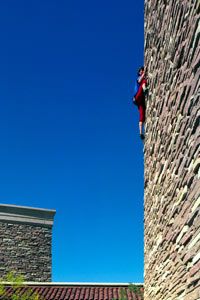Like the rocky cliffs define the Alps or the Sierra Nevada, buildings are what define the topography of urban areas. And as long there have been tall buildings, people have wanted to climb them. "Buildering" (a portmanteau of "building" and "bouldering") is the increasingly popular sport of climbing up the exterior of buildings, using many of the techniques that are used in rock climbing.
As rock climbing has grown in popularity all over the world in recent years, so has its urban equivalent. If you want to get a sense for just how big the sport has become, you need only direct your Web browser to one of several online forums used by urban climbers. There, climbers share stories and photographs of the walls that they have conquered all over the world. On forums like the one hosted at Buildering.net, climbers share wisdom about everything from climbing routes to how to survive a long fall. ("Useful stuff should you find yourself plummeting to the Earth from great height," writes one poster) [source: Buildering.net].
Advertisement
Just like rock climbing, plummeting to Earth from a great height is of course the biggest danger associated with urban climbing -- especially if you're doing it without safety gear like ropes, a harness and a helmet. But falling isn't the only risk faced by people who make a hobby of scaling buildings. It's illegal in most places, and if you get caught doing it, it can earn you jail time.
So why do people do it? Just like rock climbing, most climbers, well, climb just to climb. Every climber probably does it for a different reason, but buildering enables a climber to experience the city in a different way than most of us normally do. The climb itself must provide an enormous adrenaline rush, and it of course provides great views once you get to the top. Scaling a structure that's supposed to be off limits probably also gives them the satisfaction of eating the forbidden fruit and conquering something, but those barriers to entry also help to prevent buildering from entering the mainstream.
Advertisement




